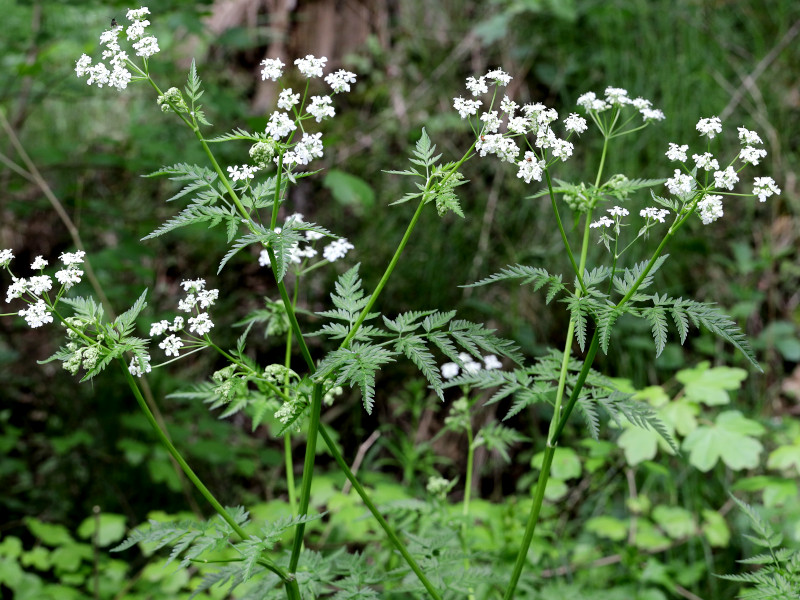Wise Mind Herbs
Evidence-based Herbal Healing
The information on this page has been prepared with reference to published scientific literature, not by a medically qualified expert. It is not medical advice. Any decision to use a supplement or herb-based product is your responsibility. Consult a suitably qualified medical professional, especially if you have underlying conditions. Remember, nothing is for everyone, and not everything sold is what it claims to be. Some things work for some people, some of the time.
Cow parsley - Anthriscus sylvestris
Cow parsley (Anthriscus sylvestris), also known as wild chervil, wild beaked parsley, or keck, is a flowering plant in the Apiaceae family native to Europe, Western Asia, and Northwestern Africa. It should not be confused with garden chervil (Anthriscus cerefolium), which is closely related but distinct, or with other similar-looking plants such as hemlock (Conium maculatum), which is highly toxic, or Queen Anne's lace/wild carrot (Daucus carota).

Current Scientific Understanding
Despite its traditional use in some folk medicine practices, there is a significant lack of robust clinical research on cow parsley. Most available studies are preliminary in vitro or animal studies, with very few human clinical trials. This creates substantial knowledge gaps regarding efficacy, safety, and appropriate dosing in humans.
Potential Health Benefits Under Investigation
The limited research suggests several potential properties that require further study:
- Antioxidant activity: Several in vitro studies have identified compounds with free radical scavenging properties, primarily from leaf extracts.
- Anti-inflammatory potential: Some lab studies suggest modest anti-inflammatory effects from specific extracts.
- Antimicrobial properties: Preliminary research indicates certain compounds may have inhibitory effects against some bacterial strains in laboratory settings.
- Some of the chemical constituents of Cow Parsley show promise for their anti-cancer properties.
It's important to note that these findings are preliminary and have not translated to proven therapeutic applications in humans. No credible peer-reviewed research demonstrates that cow parsley "cures" any medical condition.
Active Compounds
- Coumarins: Including herniarin and umbelliferone
- Flavonoids: Various types identified in leaf extracts
- Volatile oils: Including myristicin and various terpenes
Dosage Information
No standardized or evidence-based dosing protocols exist for cow parsley. The lack of clinical trials means there is insufficient data to establish safe and effective dosage ranges for any medical purpose. The absence of standardization in existing preparations further complicates dosing considerations.
Safety Concerns and Side Effects
- Cross-reactivity: Potential allergic reactions in individuals with allergies to other Apiaceae family plants
- Phototoxicity: Some coumarins may increase skin sensitivity to sunlight
- Misidentification risk: Cow parsley closely resembles highly toxic plants such as hemlock (Conium maculatum) and water hemlock (Cicuta species), posing significant risk of poisoning
- Drug interactions: Potential but unstudied interactions with anticoagulants and other medications
- Pregnancy and lactation: No safety data exists, therefore use is not recommended
Studies examining doses above any theoretical "therapeutic" range are non-existent in peer-reviewed literature. This represents a critical knowledge gap regarding toxicity thresholds and potential cumulative effects.
Commercial Pharmaceutical Products
There are currently no FDA-approved or EMA-approved pharmaceutical medications containing cow parsley extracts or compounds derived from cow parsley. Unlike some other medicinal plants that have led to pharmaceutical development, cow parsley has not been successfully developed into regulated pharmaceutical products.
Current Research Status
Research into cow parsley remains in early preclinical stages. No meta-analyses specifically focusing on cow parsley's medicinal properties were identified in peer-reviewed literature between 2020-2024. The plant has received limited attention from the pharmaceutical research community compared to other medicinal plants.
Conclusion
While cow parsley contains bioactive compounds with theoretical potential, there is insufficient scientific evidence to support its use for any specific health condition. The significant risk of misidentification with highly toxic lookalike plants, combined with the lack of standardization and clinical safety data, raises substantial safety concerns. Individuals interested in plant-based therapies should consult healthcare providers about evidence-based alternatives with established safety and efficacy profiles.
References
Kim, S. B., Lee, A. Y., Chun, J. M., Lee, A. R., Kim, H. S., Seo, Y. S., ... & Kwon, B. I. (2019). Anthriscus sylvestris root extract reduces allergic lung inflammation by regulating interferon regulatory factor 4-mediated Th2 cell activation. Journal of ethnopharmacology, 232, 165-175.
Lee, S. A., Moon, S. M., Han, S. H., Hwang, E. J., Hong, J. H., Park, B. R., ... & Kim, C. S. (2018). In vivo and in vitro anti-inflammatory effects of aqueous extract of Anthriscus sylvestris leaves. Journal of medicinal food, 21(6), 585-595.
Lee, S. A., Moon, S. M., Han, S. H., Hwang, E. J., Park, B. R., Kim, J. S., ... & Kim, C. S. (2018). Chondroprotective effects of aqueous extract of Anthriscus sylvestris leaves on osteoarthritis in vitro and in vivo through MAPKs and NF-κB signaling inhibition. Biomedicine & Pharmacotherapy, 103, 1202-1211.
Olaru, O. T., Niţulescu, G. M., Orțan, A., & Dinu-Pîrvu, C. E. (2015). Ethnomedicinal, phytochemical and pharmacological profile of Anthriscus sylvestris as an alternative source for anticancer lignans. Molecules, 20(8), 15003-15022.
Orčić, D., Berežni, S., & Mimica-Dukić, N. (2022). Phytochemical and biochemical studies of wild chervil (Anthriscus sylvestris). Biologia Serbica, 44(1).
Zhang, M., Ji, X., Li, Y., Chen, X., Wu, X., Tan, R., & Jiang, H. (2024). Anthriscus sylvestris: An overview on Bioactive Compounds and Anticancer Mechanisms from a Traditional Medicinal Plant to Modern Investigation. Mini Reviews in Medicinal Chemistry, 24(12), 1162-1176.